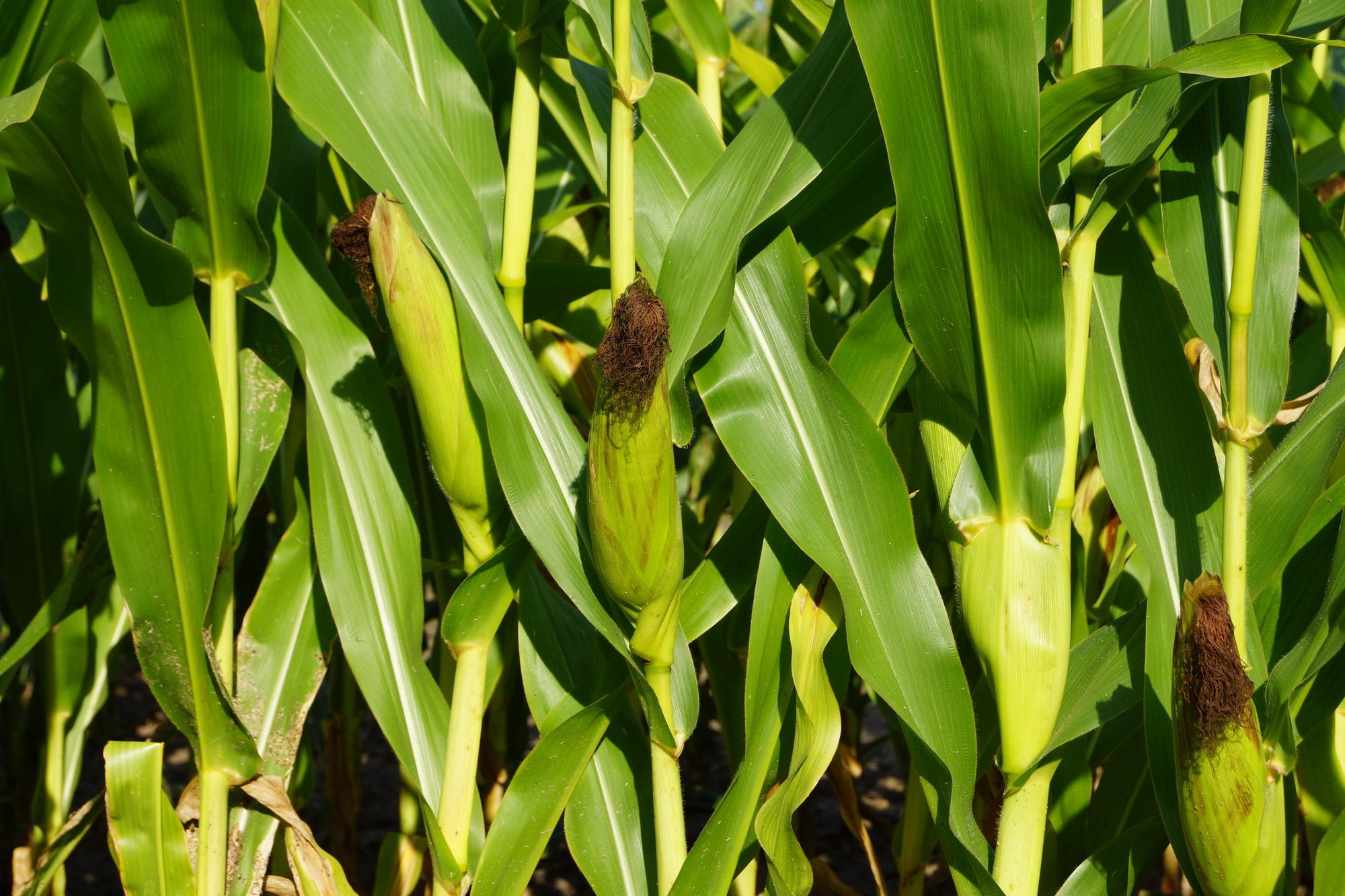Corn Donation Tracker
Quick Links: How & Where to Grow | Temperature | How to Care For | Harvest Signs | Harvesting | Pests | Companions | Varieties | Preservation | Recipes | Michigan Tips | Fun Facts
🌱 How & Where to Grow Corn:
- Plant in blocks (minimum 4 rows) when soil reaches 60°F – corn is wind-pollinated!
- Space seeds 8-12 inches apart in rows 30-36 inches apart.
- Plant 2-3 seeds per hole, 1-2 inches deep, thin to strongest seedling.
- Block planting ensures good pollination – single rows produce poorly filled ears.
- Sunlight: Full sun (8+ hours) essential for sweet kernels.
- Soil Type: Rich, well-drained soil with pH 6.0-7.0.
- Soil Amendment: Heavy feeder – needs nitrogen-rich soil.
Plant different varieties at least 250 feet apart or 2 weeks apart to prevent cross-pollination!
🌡️ Temperature Guidance:
Minimum 60°F standard, 65°F super-sweet. Nights above 50°F.
- Standard corn: Plant when soil reaches 60°F (mid-May).
- Super-sweet varieties: Wait for 65°F soil for best germination.
- Optimal growth: 70-85°F days, nights above 60°F.
- Growth slows dramatically below 50°F.
- Frost kills corn at any stage of growth.
Michigan’s warm summers are perfect for corn – patience in spring pays off with sweet summer ears!
💧 How to Care for:
- Consistent Moisture: Critical during tasseling and silk emergence.
- Watering: 1-1.5 inches weekly – increase during silk/tassel stage.
- Mulch: 3-4 inches to retain moisture and suppress weeds.
- Fertilizer: Side-dress with nitrogen when plants are knee-high.
- Weed Control: Keep weed-free until plants are established – corn doesn’t compete well.
📏 Harvest Signs:
Silks brown/dry. Milky juice from kernels. 18-23 days after silking.
- Silk appearance: Dark brown and dry to the touch.
- Ear feel: Full and firm through the husk.
- Kernel test: Pierce with fingernail – milky juice means ready!
- Husk color: Still green but starting to dry at tips.
- Each stalk typically produces 1-2 ears, top ear ripens first.
Morning harvest provides the sweetest corn – sugars are highest before day’s heat!
🧺 Harvesting:
Twist and pull downward. Harvest in early morning. Use immediately for best sweetness.
- Grasp ear firmly and twist while pulling down and away from stalk.
- Check one ear first before harvesting all – peel back small section of husk.
- Harvest quickly – corn is only at peak for 3-7 days.
- Cool immediately – plunge in ice water to preserve sweetness.
- Use within hours – corn loses 50% of sugar in 24 hours at room temperature!
🪲 Michigan Pests:
Corn earworm (mineral oil in silks), European corn borer, raccoons.
- Corn earworm: Apply mineral oil to silk tips 3-4 days after silk emerges.
- European corn borer: Look for holes in stalks – choose Bt varieties.
- Raccoons: Electric fence or harvest one day early when they start visiting.
- Birds: Cover ears with paper bags after pollination.
- Corn smut: Gray fungal galls – remove and destroy (though edible as huitlacoche!).
🫱🏽🫲🏼 Companions:
Three Sisters: Corn supports beans, beans fix nitrogen, squash shades soil.
- Traditional method: Plant corn first, beans when corn is 6 inches, squash 1 week later.
- Pole beans use corn stalks as natural support.
- Winter squash spreads between rows, suppressing weeds.
- Avoid tomatoes – they attract same pests.
- Sunflowers can be planted on north side.
🌽 Varieties:
Early: ‘Early Sunglow’. Mid: ‘Silver Queen’, ‘Butter and Sugar’.
- ‘Early Sunglow’: 63 days, yellow, good for short seasons.
- ‘Silver Queen’: 92 days, white, classic sweet corn.
- ‘Butter and Sugar’: 78 days, bicolor, very sweet.
- ‘Peaches and Cream’: 70 days, bicolor, SE type stays sweet longer.
- ‘Glass Gem’: 110 days, ornamental rainbow kernels.
🫙 Preservation:
Freeze blanched 4-6 minutes. Pressure can. Dry kernels.
- Freezing on cob: Blanch small ears 7 minutes, large 11 minutes.
- Freezing kernels: Blanch ears 4 minutes, cool, cut off kernels.
- Pressure canning: Only safe method – process according to altitude.
- Drying: Leave on stalk until husks are brown for popcorn/ornamental.
- Fresh storage: Only 1-3 days in refrigerator with husks on.
🧑🏽🍳 Recipes:
Corn on the cob, corn chowder, Mexican street corn, corn salsa, succotash.
- Grilled corn with herb butter – leave husks on for steaming.
- Fresh corn and tomato salad with basil.
- Elote (Mexican street corn) with mayo, cotija, and chili.
- Corn fritters – use fresh kernels in batter.
- Traditional succotash with lima beans.
✋🏼 Michigan Tips:
- Wait until Memorial Day weekend for main planting.
- Succession plant every 2 weeks through June for continuous harvest.
- Choose early varieties for first planting, main season for later.
- Michigan’s humidity can increase disease – space properly.
- Plant on north side of garden to avoid shading other crops.
- Consider isolation distances if saving seeds.
🧠 Fun Facts:
- Corn is actually a grass – the tallest annual grass!
- Each silk connects to one kernel – 800 kernels means 800 silks.
- An ear of corn always has an even number of rows.
- Corn is native to the Americas – developed from teosinte 9,000 years ago.
- Michigan ranks 11th in U.S. corn production.
- Corn is used in over 3,500 products including fuel and plastics.
- The world record corn stalk was 45 feet tall!
- Popcorn pops because moisture in the kernel turns to steam.


0 Comments